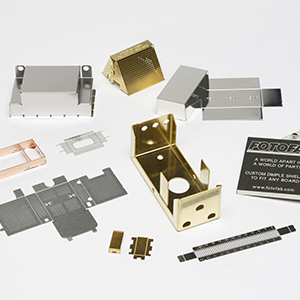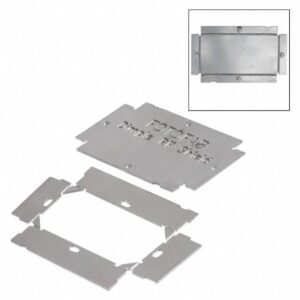This website uses cookies so that we can provide you with the best user experience possible. Cookie information is stored in your browser and performs functions such as recognising you when you return to our website and helping our team to understand which sections of the website you find most interesting and useful.
EMI and RFI Shielding Materials, Shaping, and Finishing Options
As artificial intelligence (AI), machine learning, robotic process automation, edge and quantum computing, virtual and augmented reality, Internet of Things (IoT), and 5G continue to advance, the need for EMI and RFI shielding will continue to grow.
Shielding components protect electronic devices from electromagnetic interference (EMI) and radio frequency interference (RFI), so they can properly function. Without them, advancements in electronic engineering would be impossible.
Selecting Materials for EMI/RFI Shielding
The amount of protection a shield provides depends on the shield’s material, thickness, size of the shielded volume, and the frequency of the fields of interest. There are a variety of materials used for EMI and RFI shielding. The type of material you choose will depend on the frequencies and associated wavelengths you are shielding against. Some of the most common EMI and RFI shielding materials used for various applications are copper, brass, and aluminum. Other materials include:
- MuMetal (Permalloy or Hy-Mu 80)
- Carbon Steel
- Nickel Silver
In general, shielding against frequencies of 15 MHz or lower is a bulk material effect and is best served by employing a ferromagnetic metal such as steel.
For greater attenuation at lower frequencies, you will want to consider metals with higher permeability and lower core losses, such as a MuMetal like Permalloy 80® or Hy-Mu 80. Frequencies greater than 15MHz create more of a skin (conductivity) effect, so almost any metal including brass, nickel silver, copper, and steel will shield similarly, assuming the thickness of the metal is .002” (.05 mm) or greater.

Shaping Methods for Shielding
Once you have decided the type of material you will use for your shield, our etching process develops EMI and RFI shielding components on flat sheets of metal. We can then ship them within the flat sheets, detach them per your request, or form them for you before shipping. There are several ways to shape shields, including:
- Machine Forming
- Stamping
- Hand Forming
Machine Forming Shields
Here at Fotofab, we have a full range of metal bending and forming services on a rapid delivery basis that fit within the budget and technical needs of our customers.
Our solutions include single stage forming, simple in-house made tooling, as well as progressive dies so we can control quality and lead times. Using our kick presses, we break the forming process up into multiple stations, with each stage performing a single bend. For example, one station will form 90° bends and another station will perform 30° bends. This process and layout save both time and money for short run, small volume, and prototype projects. The results are very precise and repeatable.
Shield Stamping
Once a part has reached a stable design and is ready to go into high volume production, stamping can be a better manufacturing option. This automated process involves a customized tool to punch and form the part from sheet metal or metal strips.
The tool creation requires a longer lead times, but once completed, parts can be made quickly, saving on production costs. Fotofab uses punch presses and 4-slide machines for higher volume production runs.
Hand Forming Shields
Hand-foldable, etched bend channels are one of the unique features we can incorporate into our RFI/EMI shielding project. The bend channels allow anyone to easily bend the sidewalls of a shield from a 2D blank to a 3D finished shield quickly and precisely. We can hand form the shields at our facility or ship them in flat sheets for you to hand-form yourselves.
Etched bend channels not only save you costs, but they also exhibit a zero inside radii when formed. This allows you to save space on your board by reducing the clearance necessary between the shield and the components within it.
The bend channels can also create acute angle bends between 0° and 90°. However, if your application is load bearing or subjected to extreme vibration, we recommend other forming tools to bend your shield, which will create inside bend radii equal to the metal thickness, at minimum.
The bend channels are created through selective chemical etching, meaning we remove anywhere between 50 and 75 percent of the original metal thickness. This will affect the strength of the metal along these bend channels proportionally.
Other Finishing Options for Shielding Applications
Other finishing options we offer for your shielding applications include:
- Dimpling
- Electropolishing/Electroplating
- Custom Packaging
Dimpling for Shields
If your application requires a removable cover so that the components underneath can be tweaked or replaced, Fotofab offers dimpling, or mating dimples, to keep the top part of the shield source to the bottom half.
Dimpling is a form of mechanical locking method for two-piece shields.

Electroplating EMI and RFI Shields
Most materials used to make EMI and RFI shields are not strongly corrosion-resistant or solderable without a flux, so we offer electroplating to help with this. Common electroplate finishes for shielding include:
- Tin (ASTM B545, MIL-T-10727)
- Lead free or tin/lead
- Bright or dull finish
- Reflow
- Nickel Sulfamate (AMS-QQ-N-290, ASTM B689, QQ-N-290, MIL-P81728)
- Dull finish
- Excellent for solderability and ductility
- Base plate for Tin
- Electroless Nickel (AMS-2404, ASTIM B733, MIL-C-26047)
- Delicate finish
- Absorbs oil
You do want to watch out for Nickel Sulfate, which is bright and shiny but not solderable and very brittle when bent.
Custom Packaging for EMI and RFI Shielding
There are several ways to ship a product after it has been etched. For parts that need to remain flat or formed after they have been shipped, we recommend shipping etched parts tabbed into the metal sheet, or panel.
However, for formed shields we offer customer supplied packaging options and:
- Boxed packaging with foam inserts to protect the shape from distortion.
- Pick and place trays for automated pick and place equipment that assembles parts using automation processes.
- Tubes for single-part pieces.
- Tape and reel packaging for high volume production projects.
When creating shields, moving from one vendor to another for a variety of value-added services can increase the overall cost and lead time of your project. Using manufacturers, such as Fotofab, as a sole source for all your shielding needs can help you get your project to completion fast and efficiently.

